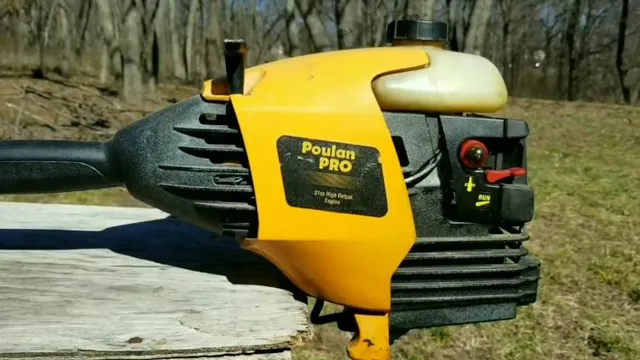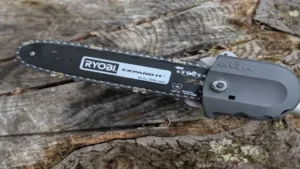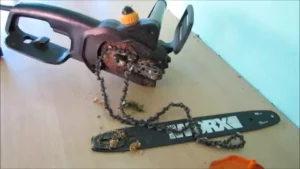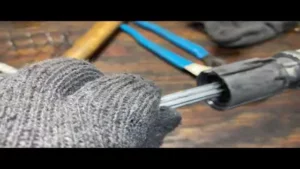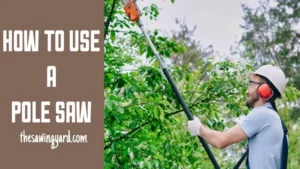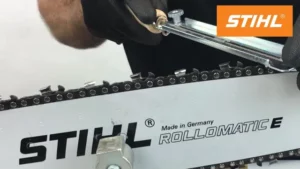As a proud owner of a pole saw, you know the importance of having it readily available for all those outdoor maintenance tasks. But when it’s not in use, how do you properly store your pole saw to ensure its longevity and functionality? In this blog, we will discuss some handy tips and tricks for storing your pole saw so that it’s always ready when you need it. From cleaning and maintenance to finding the right spot for storage, we’ve got you covered.
So let’s dive in and learn how to properly store your pole saw for optimal performance.
Clean Your Pole Saw
When it comes to storing your pole saw, it’s important to give it a good cleaning first. This ensures that all the dirt and debris from previous use are removed and won’t attract pests or cause damage to the tool in storage. Begin by wiping down the blades with a damp cloth or a soft-bristled brush to remove any residual sap or dirt.
If the blades are particularly dirty, you can use a solution of mild dish soap and water to help loosen any buildup. Once you’ve cleaned the blades, be sure to dry them thoroughly to prevent rusting. You can also use a lubricant, such as WD-40, to prevent rust and ensure smooth operation when you use the saw again.
Finally, store the saw in a cool, dry place where it won’t be exposed to moisture or extreme temperatures. With proper care and storage, your pole saw will last for many years and provide reliable performance whenever you need it.
Remove Debris and Dirt from Saw Blades and Handle
If you’re someone who likes to do things on your own rather than hiring professionals, then you’ll know how important it is to keep your tools clean and well-maintained. This is especially true for tools like pole saws, which tend to collect a lot of dirt and debris over time. One important aspect of maintaining a pole saw is to regularly clean the blades and handle.
This involves removing any dirt, debris, or sap that might have accumulated on them. To do this, you can use a soft cloth or brush to wipe the blades and handle down. It’s essential to use cleaning solutions that do not damage the materials of which the pole saw is made.
You can mix warm water and soap or a vinegar solution to clean the blades and handle. Just ensure the cleaning solution is dry before storing the pole saw. By regularly doing this, you’ll increase the longevity of your pole saw and ensure that it continues to function correctly.
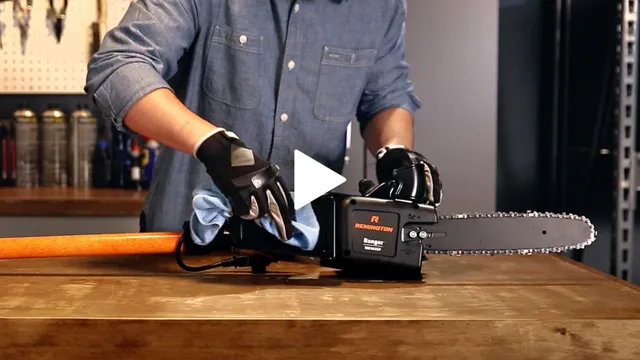
Disassemble the Pole Saw
If you want to store your pole saw properly, disassembling it can be a wise decision. Here’s how to do it: first, loosen the locking mechanisms that hold the different sections of the pole together. Once they’re released, gently twist and pull the sections apart, one at a time.
If you encounter any resistance, don’t force it, but instead try tilting the saw to a different angle to loosen it. Once the pole saw is in its individual pieces, wrap them in a cloth or towel to keep them from getting scratched and store them in a safe, dry place. Disassembling your pole saw can make it more compact and easier to store, while also protecting it from damage that might occur if left assembled and exposed to the elements.
It’s an essential step in prolonging the lifespan of your pole saw and keeping it in prime condition for the next time you need it.
Remove the Blade from the Pole
If you’re looking to disassemble your pole saw and remove the blade, you’ve come to the right place. First, ensure that the saw is not connected to any power source before attempting to remove the blade. Then, locate the bolt that’s holding the blade in place by examining the base of the blade where it meets the pole.
Depending on your model, there may be a specific tool required to turn the bolt. Once the bolt is loosened, gently slide the blade off of the pole. Remember to take extra care when handling the blade, which is sharp and can easily injure you if you’re not careful.
By following these easy steps, you can safely remove the blade from the pole saw and disassemble the tool as needed.
Detach the Handle from Pole
If you’re looking to disassemble your pole saw, there are some simple steps you can follow to safely and efficiently take it apart. One of the first things you’ll want to do is detach the handle from the pole. This is a relatively easy process that will involve locating and removing any screws or fasteners that are holding the two pieces together.
Once you’ve done this, you should be able to gently pull the handle away from the pole and set it aside. This will give you access to the various components of the saw, including the blade, chain, and other mechanical parts that may need to be serviced or replaced. By taking the time to properly disassemble your pole saw, you can ensure that it remains in good working order and is ready to tackle any job you throw at it.
Choose the Right Storage Location
When it comes to storing your pole saw, choosing the right location is key. You want to keep it in a place that is dry, free of moisture, and out of direct sunlight. A basement or garage is a good option, as long as the area is well ventilated and doesn’t experience extreme temperature changes.
It’s also important to keep your pole saw stored in a safe location, away from pets and children. Consider using a storage rack or hanging system to keep it off the ground and prevent any damage. Additionally, make sure to clean your pole saw before storing it, removing any debris or sap residue to prevent rust and corrosion.
With the right storage location and proper maintenance, your pole saw will be ready for use whenever you need it.
Find a Dry and Cool Space
When it comes to storing your belongings, it’s important to choose the right location. You want to find a dry and cool space, such as a basement or a closet, that will protect your items from moisture and extreme temperatures. Avoid areas that are damp or prone to flooding, as this can cause damage to your belongings.
Make sure the area is well-ventilated to prevent any musty odors from settling in. Additionally, keep in mind the size of your items and the amount of storage space you need. This will help you determine the best location for your belongings.
By choosing the right storage location, you can ensure that your items remain in good condition and are easily accessible when you need them.
Keep Away from Children and Pets
When it comes to storing household items, it’s essential to keep them out of reach of children and pets. Many products, including cleaning agents, medicines, and even food items, can pose a significant risk if ingested by curious children or animals. So, it’s crucial to choose the right storage location for these items.
Perhaps the easiest way to do this is to store them in a locked cabinet or high shelf that is not accessible to kids or pets. Additionally, make sure to label the items correctly and ensure that they are not kept in the same place as everyday items that children or pets may access easily. Overall, choosing the right storage location will prevent accidents and ensure the safety of everyone in your household.
Remember, keeping products out of sight and reach keeps everyone safe!
Secure Your Pole Saw
Looking to store your pole saw safely? Whether you’re a novice or an experienced gardener, it’s essential to keep your pole saw in good condition. The first step is to keep it in a dry place, where it won’t be exposed to moisture or dampness. You can hang it on a pegboard or use a wall-mounted storage unit to keep it organized and easy to access.
When your pole saw isn’t in use, it’s best to cover it with protective sheaths to prevent damage or scratches. Make sure to sharpen the blade before storing it to ensure its effectiveness the next time you need to use it. It’s also a good idea to keep your pole saw away from children or pets for safety reasons.
With these tips, you can secure your pole saw and prolong its lifespan, so it stays efficient and ready for use when you need it most.
Hang It on a Wall Hook
If you’re tired of trying to find a safe spot to store your pole saw, consider investing in a wall hook. Hanging your tool not only keeps it out of the way, but it also ensures it’s secure and easy to access when needed. Wall hooks are easy to install and come in a variety of shapes and sizes to accommodate different tools.
Plus, they allow for quick and easy access to your pole saw, which means you won’t have to waste time searching for it in a cluttered garage or shed. Using a wall hook also helps to protect your tool from damage, as it won’t be knocked over or stepped on when it’s not in use. Invest in a sturdy wall hook and you’ll be able to keep your pole saw safe and secure for years to come.
Place It on a Storage Rack
When it comes to maintaining your pole saw, finding a suitable storage solution is key. A storage rack is an excellent option for securing your pole saw when it’s not in use. Keeping your pole saw stored on a rack not only prevents it from getting damaged but also allows for easy access when you need it.
There are different types of storage racks, including wall-mounted and freestanding options, so you can choose the style that suits your needs and space. Just be sure to properly secure your pole saw to the rack to prevent it from falling or being knocked over. By placing your pole saw on a storage rack, you’ll be able to keep it safe and organized for years to come.
Maintenance Tips
When it comes to storing your pole saw, there are a few key tips you’ll want to keep in mind to ensure it stays in great shape. First and foremost, it’s important to clean your saw thoroughly before storing it. Use a damp cloth to wipe down all the components, making sure to remove any debris or dirt buildup.
Next, consider investing in a protective cover or case to keep your saw safe from dust and moisture. If you don’t have a cover, storing your saw in a dry, secure location will also do the trick. Finally, make sure to store your saw in a position that won’t put excessive pressure on the blade or other components.
By following these simple tips, you can help extend the lifespan of your pole saw and ensure it’s ready to use next time you need it!
Regular Cleaning and Inspection
Regular cleaning and inspection are essential for maintaining the quality and longevity of your appliances, furniture, and the overall infrastructure of your home. It is crucial to keep your living space organized, tidy, and safe for everyone living in it. Therefore, it is recommended to set a fixed routine for cleaning and ensuring regular inspection of various systems such as HVAC, plumbing, and electrical.
By doing so, you can reduce the occurrences of breakdowns, decay, or hazards that may arise. Additionally, regular maintenance ensures that all appliances, outlets and systems operate efficiently, reducing your energy bills and preventing costly repairs in the future. So, set a schedule and ensure that all areas, including basements, attics, and crawl spaces, are cleaned and inspected regularly.
Taking these simple steps can go a long way in keeping your home safe, comfortable and efficient.
Sharpen the Saw Blade As Needed
When it comes to maintaining your saw blade, there are a few important things to keep in mind. One of the most important things is to sharpen the blade as needed. A dull saw blade is not only less effective, but it can also be dangerous.
A sharp blade, on the other hand, will make cutting smoother and more efficient. To sharpen your blade, you can use a saw file or a sharpening stone. It’s important to follow the proper technique and angle when sharpening, so if you’re unsure, it’s a good idea to consult a professional.
Additionally, it’s important to clean and oil your blade regularly to keep it in good working condition. By taking these simple steps, you can keep your saw blade sharp and effective, ensuring clean, precise cuts every time you use it.
Conclusion
In conclusion, storing a pole saw is like storing a secret weapon – you want to keep it safe and ready for action. The key is to find a spot that is both accessible and out of the way, and to protect the saw from dust, rust, and accidental damage. Whether you choose to hang it on the wall or tuck it away in a corner, remember that a well-cared-for pole saw is a powerful tool that can help you tame even the unruliest of branches.
“
FAQs
What are the different ways to store a pole saw?
One way to store a pole saw is to hang it onto a wall using hooks or a pegboard. It can also be stored in a storage box or a dedicated saw storage rack. Another option is to dismantle the pole saw and store it in separate parts.
How can I protect my pole saw during storage?
To protect your pole saw during storage, you can cover the blades with blade covers or a cloth. Make sure to clean and oil the blades before storing and keep them away from moisture and direct sunlight.
Can I store my pole saw outside?
It is not recommended to store a pole saw outside as it can be damaged by moisture, sunlight, and fluctuating temperatures. It is best to store it indoors in a dry and safe place.
How often should I check my pole saw during storage?
It is recommended to check your pole saw every three months during storage to ensure that the blades are still sharp and there is no rust or damage. If you notice any issues, take the necessary steps to repair or replace the parts before using it again.
How should I transport my pole saw?
To transport your pole saw, it is best to detach the blades and secure them with blade covers or cloth. The pole should be strapped or placed in a padded storage bag to prevent scratches and damage during transport.
Can I store my pole saw with other tools?
It is not recommended to store your pole saw with other tools as it can lead to damage or dulling of the blades. It is best to store it separately in a dedicated storage area.
What should I do before storing my pole saw for a long period of time?
Before storing your pole saw for a long time, make sure to clean and oil the blades, check for any damage or wear and tear, and store it in a dry and safe place away from moisture and direct sunlight. It is also a good idea to detach the blades and store them separately to prevent rust and damage.
